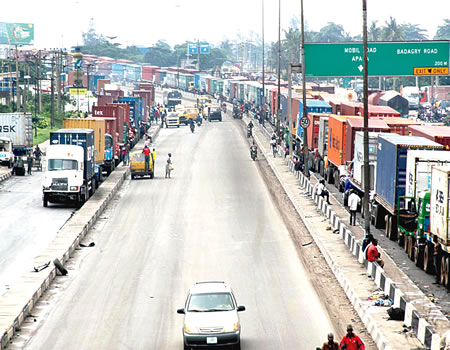Apapa port is the nation’s busiest seaport. In the early 70s, after the Civil War, six berths of 943 meters were added to the existing the port’s infrastructure. Later, the Federal Government added four more berths with a total quay length of 506 meters, completing the extension of the second Apapa wharf.
The Apapa port was built to handle 38 million metric tons of cargo, while the volume of trucks that use the ports are about 2000 trucks every day.
Before the concession of ports in 2006, the volume of trucks that visited the ports did not exceed the available infrastructure. This long queues of trucks caused traffic gridlock at Apapa. Then, the port was managed by the Nigerian Ports Authority (NPA), a Federal Government parastatal
The only time there was congestion at the ports in the 70s was immediately after the war when the Federal Government embarked on massive rebuilding and reconstruction of damaged infrastructure. By the middle 70s, vessels carrying cement and waiting to discharge at the ports, had exceeded 500, thus began the congestion of Apapa port.
However, the commissioning of the ultra modern Tin-Can Island port on October 14, 1977, eased the congestion at Apapa ports, but increase in tonnage of the ports kept causing congestion at both the Apapa and Tin-Can ports from the late 80s to early 90s.
The need for an efficient port became increasingly unavoidable post civil war, thus machinery was put in place by the Olusegun Obasanjo administration towards the privatisation of the nation’s seaports, which ushered in the 2006 Port Reform.
Post concession
The relative peace experienced in Apapa would change, at least for the next 13 years, when the Federal Government, through the NPA, concessioned the port in 2006. Under the port reform, the organised private sector took over the management of Nigeria’s ports facilities and terminals, and the NPA only provided supervisory roles in what has become known as the Landlord-Tenant port model.
By the end of 2011, Nigerian ports recorded a cargo throughput of 82.76 million tonnes, which was a 7.8 per cent increase over the volume of 76.74 million tonnes achieved in 2010. However, despite the euphoria that greeted the 2006 reform, arrangement to provide truck holding bay for trucks during the reform period did not succeed.
Beside that, the new private port operators took over all truck packing spaces, hitherto enjoyed by truckers under an NPA controlled ports, thereby leaving the truckers with no option but to park their trucks on the highways and roads adjoining the ports.
According to the Chairman of the Association of Maritime Truck Owners (AMATO), Chief Remi Ogungbemi, “immediately after the port reform of 2006, our members, who used to park inside the ports, were ordered out of the ports. Then, under an NPA-controlled port, we had parking spaces right inside the ports. But with the private owners, all truck parking spaces were converted for other uses by the new owners.
“Our members were chased out of the ports, while there was no holding bay outside. That is why you see trucks littering all the major highway leading to the ports today,” he told Sunday Tribune.
Speaking on a radio programme recently, Vice-President Yemi Osinbajo blamed congestion on the Lagos port access roads on bad roads and increased cargo volume. He accused past administrations in the country of abandoning the roads to deteriorate to their present state.
“The Apapa port was built to handle 38 million metric tonnes of cargo ant its now handling 84 million metric tonnes. That is too small for the volume that it is now handling, and which has resulted in too many trucks going into the port,” he said.
Speaking further, he said: “when we had the problem the first time, we noticed that all the roads around Apapa were bad and we agreed that we would fix it.
“We especially agreed to fix the Wharf Road down to Mile 2. We have almost completed the road around the port now; and have moved to Mile 2. We must fix the roads. If these roads are not fixed, we will continue to have the same problem.”
He, however, identified road repair, revival of the rail network, and revival of ports outside the Lagos area, as the long-term solutions to the Apapa gridlock.
Why gridlock
With increase in the volume of cargoes the ports now handle following the port reform process, the little above 2000 trucks that called at the ports can not conveniently lift all the cargoes in the ports. This means that more trucks called at the ports, which has led to over 5000 trucks calling at Apapa ports present day.
Further compounding the traffic situation on the limited Tin-Can port and Apapa access road is the huge volume of petroleum product tankers that are attracted to the petroleum tank farms located at the Coconut end of the Tin-Can Island port.
Residents flee
With the chaos in, and around Apapa, many residents, particularly, owners of choice properties inside the Apapa GRA, have fled their homes.
“Many property owners have left their homes and moved elsewhere due to difficulty accessing their homes.
“All the trailers and tankers have turned the GRA into a parking lot. People can no longer drive into their homes. To even go out of your houses is a problem.
“Sadly, shipping companies are feeding fat on unearned container deposit and demurrage, thereby encouraging the traffic gridlock. They are using Nigeria as storage facility for empty containers as the cost is next to nothing.
“Security agencies are passing trucks at N60,000 each and the NPA is closing their eyes as if nothing is happening. Unfortunately, residents and workers in Apapa are in this mess alone and if we don’t stand up for ourselves, nothing will happen.
“Anything short of physical mobilisations at this point will be meaningless. The gridlock is man-made . We have to stop it. We were supposed to stage a protest last week, but we postponed it. We will surely stage a protest soon and shut down Apapa over this gridlock. The situation is getting unbearable,” the chairman of the Apapa GRA Residents Association (AGRA), told Sunday Tribune.
National loss
In a recent publication, the Lagos Chamber of Commerce and Industry (LCCI) conducted a survey in collaboration with the Nigerian Economic Summit Group (NESG) and Manufacturers Association of Nigeria (MAN). Their findings indicated that due to the lingering gridlock, the nation loses about N3.06 trillion (or $10 billion) on non-oil export, and about N2.5 trillion corporate earnings across the sectors annually.
They all concluded that the cumulative forfeiture is within the bracket of Nigeria’s national budget.
“The implication of this is that budget deficit may become a thing of the past if the Federal Government would handle Apapa gridlock deftly and formulate policies to optimise revenue generation at seaports across Nigeria”.
Way forward
Stakeholders have, over the years, lamented the lack of an inter-modal system of cargo evacuation at the ports.
For years, the ports have depended on the roads for cargo evacuation, thereby leading to the breakdown of the highways connecting the ports. However, with the effort of the Federal Government to connect the ports to the ongoing standard gauge project, there seems to be a glimmer of hope in the horizon for Apapa and its environs.
Osinbajo, expressed the plans of the government, when he said three things must be done to find a long term solution to Apapa gridlock
“The first is that now we are building Lagos-Kano Railway and the first phase is Lagos-Ibadan, starting from Apapa Port. So, many of the goods will be evacuated by rail. The Lagos-Ibadan phase should be completed by January 2019, and hoping to finish its construction to Kano in about two and a half years.
“The second is that we have other ports. We have Calabar, which we are dredging to about 10 meters. So, we have to make sure we can divert some traffic there.
“If we can divert traffic away from Lagos ports, it will help, but it will not solve the problem completely because 60 per cent of business is being transacted in Lagos. So, when people import goods to Nigeria, they will want to use it in Lagos, which is the problem we have. That’s why we need to fix the railway, finish the roads and then, fix the other ports. This will definitely make things much better.
“Railway is the best way to transport goods all around the country, inland port, dry port. Once we fix the Port Harcourt-Maiduguri, Lagos-Calabar, Lagos-Kano railways, the Apapa issue is a small thing because it will boost business, manufacturing activities and people can easily move their goods from one part of the country to another.”






